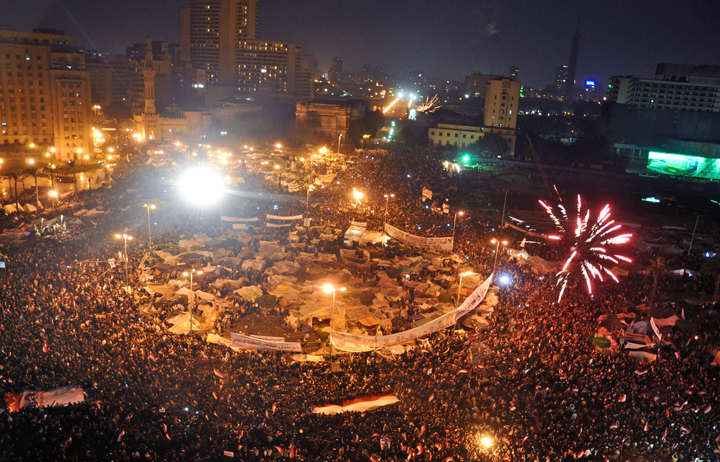
This post coincides with Friday's release of an ASPI Insight paper by Lydia Khalil entitled Trends in a tumultuous region: Middle East after the Arab Awakening.
The Middle East has seen its share of troubles, but this tumultuous region is arguably going through its most transformative and turbulent time in its modern history. Two years ago, a wave of people power protests toppled numerous long-standing regimes in the region in Tunisia, Egypt, Yemen and Libya. It ushered in reforms and changes to many more. It was a hopeful and transformative time.
The hope was that the Middle East had finally found its path towards a more representative and prosperous future after decades of stagnation and dictatorships. This hope quickly soured. The removal of dictatorships created a power vacuum that was filled by political jockeying between Islamists and secularists, and by sectarianism and neo-militarism. With the possible exception of Tunisia, which has begun to adopt a more inclusive and reconciliatory approach to post Ben Ali governance, there have been no truth and reconciliation like approaches in any of the countries. Zero-sum politics maintains its grip, especially in Syria, which has devolved into a horrific civil war.
The current trends are troubling. What began as a positive story of peaceful revolutions has deteriorated into political mayhem, instability and war. The economic and social problems that drove the initial protests have got worse, not better, not helped by the civil war in Syria, a popularly sanctioned military coup in Egypt, and continued violence in Iraq and Libya.
There's a marked uptick in sectarianism and sectarian violence, not only in the obvious places like Iraq and Syria, but in Egypt and Yemen. Religious minorities are in precarious positions in many countries, and the Shia–Sunni divide is widening across the region. National sectarian conflicts aren’t contained within their countries, but have far-reaching regional implications, especially in the case of Syria, which is fast becoming a regional proxy war.
There's also a widening rift between secular and Islamist political forces. Because of recent setbacks for Islamist political parties, particularly the vaunted Muslim Brotherhood in Egypt, we're witnessing a political Islam that’s more prone to violence, less willing to participate in elections and less able to exert organisational discipline. In the future, it'll be even less willing to work with liberal and secular forces, portending a continuous divide across the region.
The gradual disengagement and declining influence of the US in the Middle East may be welcome in some quarters, but it diminishes powerful leadership in a troubled region. The United States’ reluctance to get involved in the Syrian conflict and its ambivalent stance on the political developments in Egypt, as well as its disengagement from Libya after the Benghazi debacle, has hurt its standing and compromised its position as guarantor of Western interests in the region.
But all's not lost. There are glimmers of hope in this troubled region. The generation of young people who started this revolution is savvy, aware and educated, and they haven't let go of their original vision. They continue to agitate for change. In Egypt, when the presidency of Mohamed Morsi began to take on the same authoritarian tones as the previous Mubarak regime, a group of university graduate students began the
Tamarod Campaign—a petition calling for the removal of Morsi and for early elections, which culminated in 23 million signatures and massive demonstrations.
When the military takeover removed Morsi from power, liberal-minded young Egyptians kept up their campaign to try to keep the military in check. Hundreds of young people lost their lives in street battles to bring a better Egypt and, despite the incompetent tenure of the Muslim Brotherhood and a military coup, they're not willing to see the goals of the revolution slip away. They're still active and agitating, a positive sign in a country that's going through massive political upheaval.
And in Tunisia, the country that began the wave of protests, there's hope of a
political reconciliation despite a polarised climate. It doesn't have the same intrusive army as Egypt so there's little risk of a similar military coup. There continues to be dialogue among both governing and opposition parties and there are signs that the ruling Ennahda Islamist party might finally break with its Islamist allies and enter a rapprochement with secular opposition parties.
There are also positive signs coming from Iran’s newly elected Hassan Rouhani. Since his election, he has concertedly
reached out to the West. Though the devil's in the details, Rouhani’s approach and the effects of crippling sanctions on Iran is a potential path forward on nuclear negotiations. Iran’s more conciliatory stance could also bode well for Iranian assistance in Syria. In contrast to the bellicose rhetoric of Ahmadinejad, Rouhani speaks of moderation and dialogue and a serious
willingness to engage with old adversaries.
And in the last place one would think to look for progress, the stalled Arab–Israel peace process, there seems to be some movement. After years of silence, both sides have agreed to return to the negotiating table. Significantly, its seems as if Palestinian Authority President Mahmoud Abbas has already made a major concession by
not insisting on the right of Palestinian refugees to return to Israel if a fair agreement is reached.
Lydia Khalil is a visiting fellow in ASPI’s National Security Program. Image courtesy of Wikimedia Commons. Print This Post
Print This Post